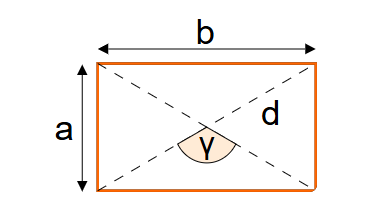1. What is the Rectangle Properties Calculator?
Definition: The Rectangle Properties Calculator computes the perimeter, area, diagonal, angle between diagonals, and circumcircle radius of a rectangle based on its width and length.
Purpose: Assists in calculating geometric properties for construction, design, or educational purposes with customizable units.
2. How Does the Calculator Work?
The calculator uses the following formulas:
Perimeter:
\[ P = 2 \times (a + b) \]
Area:
\[ A = a \times b \]
Diagonal:
\[ d = \sqrt{a^2 + b^2} \]
Angle between Diagonals:
\[ \gamma = 90^\circ \]
(The diagonals of a rectangle intersect at 90° at the center, with no obtuse angle formed due to the rectangle's right-angled nature.)
Circumcircle Radius:
\[ r = \frac{d}{2} \]
Where:
- \( a \): Width.
- \( b \): Length.
- \( P \): Perimeter.
- \( A \): Area.
- \( d \): Diagonal.
- \( r \): Circumcircle radius.
Steps:
- Step 1: Input Width and Length. Enter positive values for width (a) and length (b).
- Step 2: Select Unit. Choose from cm, m, inch, feet, or yard.
- Step 3: Calculate. Compute all properties with fixed 4 decimal place precision.
3. Importance of Rectangle Property Calculation
Calculating rectangle properties is crucial for:
- Construction: Estimating materials for frames or floors.
- Design: Planning rectangular layouts or spaces.
- Education: Teaching geometry and spatial relationships.
4. Using the Calculator
Example 1: Width 14 cm, Length 10 cm:
- Step 1: Width = 14 cm, Length = 10 cm.
- Step 2: Perimeter = \( 2 \times (14 + 10) = 48 \) cm.
- Step 3: Area = \( 14 \times 10 = 140 \) square cm.
- Step 4: Diagonal = \( \sqrt{14^2 + 10^2} \approx 17.2047 \) cm.
- Step 5: Circumcircle Radius = \( 17.2047 / 2 \approx 8.6024 \) cm.
- Result: Perimeter = 48.0000 cm, Area = 140.0000 square cm, Diagonal = 17.2047 cm, Angle = 90°, Circumcircle Radius = 8.6024 cm.
Example 2: Width 5 inches, Length 3 inches:
- Step 1: Width = 5 inches, Length = 3 inches.
- Step 2: Perimeter = \( 2 \times (5 + 3) = 16 \) inches.
- Step 3: Area = \( 5 \times 3 = 15 \) square inches.
- Step 4: Diagonal = \( \sqrt{5^2 + 3^2} \approx 5.8309 \) inches.
- Step 5: Circumcircle Radius = \( 5.8309 / 2 \approx 2.9155 \) inches.
- Result: Perimeter = 16.0000 inches, Area = 15.0000 square inches, Diagonal = 5.8309 inches, Angle = 90°, Circumcircle Radius = 2.9155 inches.
Example 3: Width 2 m, Length 1.5 m:
- Step 1: Width = 2 m, Length = 1.5 m.
- Step 2: Perimeter = \( 2 \times (2 + 1.5) = 7 \) m.
- Step 3: Area = \( 2 \times 1.5 = 3 \) square m.
- Step 4: Diagonal = \( \sqrt{2^2 + 1.5^2} \approx 2.5000 \) m.
- Step 5: Circumcircle Radius = \( 2.5000 / 2 = 1.2500 \) m.
- Result: Perimeter = 7.0000 m, Area = 3.0000 square m, Diagonal = 2.5000 m, Angle = 90°, Circumcircle Radius = 1.2500 m.
Example 4: Width 3 feet, Length 2 feet:
- Step 1: Width = 3 feet, Length = 2 feet.
- Step 2: Perimeter = \( 2 \times (3 + 2) = 10 \) feet.
- Step 3: Area = \( 3 \times 2 = 6 \) square feet.
- Step 4: Diagonal = \( \sqrt{3^2 + 2^2} \approx 3.6056 \) feet.
- Step 5: Circumcircle Radius = \( 3.6056 / 2 \approx 1.8028 \) feet.
- Result: Perimeter = 10.0000 feet, Area = 6.0000 square feet, Diagonal = 3.6056 feet, Angle = 90°, Circumcircle Radius = 1.8028 feet.
5. Frequently Asked Questions (FAQ)
Q: What is a rectangle?
A: A rectangle is a four-sided polygon with opposite sides equal and all angles 90°.
Q: Why is the angle between diagonals 90°?
A: The diagonals of a rectangle bisect each other at 90° due to the right-angled nature of the shape.
Q: What is the circumcircle radius?
A: It’s the radius of the circle passing through all four vertices, equal to half the diagonal.
Rectangle Properties Calculator© - All Rights Reserved 2025
 Home
Home
 Back
Back
